Tegeticula intermedia
Olle PellmyrAdult Characteristics
Wing expanse 18-29 mm. Forewing wide and blunt, usually white but occasionally with more or less tan coloration in northeastern part of range. Hindwing medium to light brownish grey, darkest by apex, gradually turning white toward hind corner; generally lighter in southernmost populations. Female with vestigial maxillary tentacles. Male genitalia with aedeagus 1.3-1.5 mm long, 0.07-0.08 mm in cross section; female genitalia with posterior apophyses 4.6-5.3 mm long, corpus bursae with signa 1.20-1.30 mm in diameter.
Comparison with Similar Species
Similar to many species in the yuccasella complex, especially the largely sympatric yuccasella and cassandra, but females lack functional maxillary tentacles in this non-pollinating cheater species. Specimens with tan coloration are also assignable to intermedia. Genitalic characters are also helpful in obtaining a definitive identification. A diagnostic key is provided.
Host, Oviposition, and Larval Feeding Habits
The species is known from the capsular-fruited yuccas Yucca filamentosa (Y. smalliana, Y. flaccida), Y. glauca (Y. arkansana, Y. campestris), Y. constricta, and Y. baileyi var. intermedia.. Females oviposit into young fruit (Pellmyr 1999). Eggs are laid very superficially under the fruit surface, and the larva feeds on developing seeds. Pupation occurs in a cocoon in the soil.
Geographic Distribution
Throughout the Great Plains and areas east of it, extending into central New Mexico.

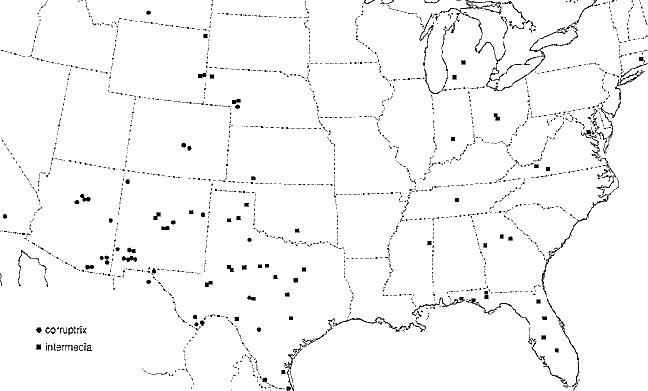
Habitat
Natural habitats include sand dunes, pine forest and glades in the east, and grassland, shrub desert, and pinyon forest elsewhere. Altitudinal range 0 - 1400 m.
Grassy shrub in Comanche Co., Texas, and a cleared area in Lowndes Co., Mississippi, represent typical habitats of host yuccas.
References
Pellmyr, O. 1999. Systematic revision of the Tegeticula yuccasella complex (Lepidoptera: Prodoxidae) north of Mexico. Systematic Entomology 24:243-271.
Title Illustrations

| Location | Wilson Co, Tennessee; Franklin Co, Ohio |
|---|---|
| Specimen Condition | Dead Specimen |
| Sex | males and females |
| Image Use |
 This media file is licensed under the Creative Commons Attribution-NonCommercial License - Version 3.0. This media file is licensed under the Creative Commons Attribution-NonCommercial License - Version 3.0.
|
| Copyright |
© 1996

|
About This Page

University of Idaho, Moscow, Idaho, USA
Page copyright © 1996
 Page: Tree of Life
Tegeticula intermedia .
Authored by
Olle Pellmyr.
The TEXT of this page is licensed under the
Creative Commons Attribution-NonCommercial License - Version 3.0. Note that images and other media
featured on this page are each governed by their own license, and they may or may not be available
for reuse. Click on an image or a media link to access the media data window, which provides the
relevant licensing information. For the general terms and conditions of ToL material reuse and
redistribution, please see the Tree of Life Copyright
Policies.
Page: Tree of Life
Tegeticula intermedia .
Authored by
Olle Pellmyr.
The TEXT of this page is licensed under the
Creative Commons Attribution-NonCommercial License - Version 3.0. Note that images and other media
featured on this page are each governed by their own license, and they may or may not be available
for reuse. Click on an image or a media link to access the media data window, which provides the
relevant licensing information. For the general terms and conditions of ToL material reuse and
redistribution, please see the Tree of Life Copyright
Policies.
Citing this page:
Pellmyr, Olle. 1996. Tegeticula intermedia . Version 01 January 1996 (under construction). http://tolweb.org/Tegeticula_intermedia/12474/1996.01.01 in The Tree of Life Web Project, http://tolweb.org/




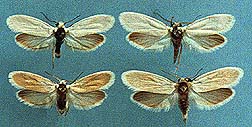
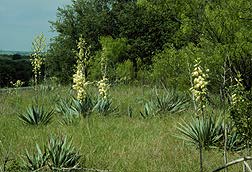
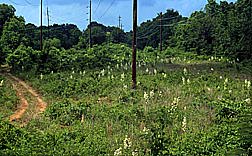
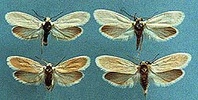


 Go to quick links
Go to quick search
Go to navigation for this section of the ToL site
Go to detailed links for the ToL site
Go to quick links
Go to quick search
Go to navigation for this section of the ToL site
Go to detailed links for the ToL site